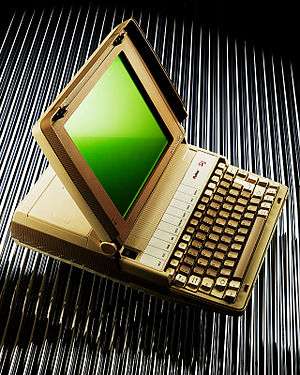Data General-One
The Data General-One (DG-1) was a portable personal computer introduced in 1984 by minicomputer company Data General.
 A Data General-One laptop computer | |
| Manufacturer | Data General |
|---|---|
| Type | personal computer |
| Release date | 1984 |
| Introductory price | US$2895[1] |
| Operating system | MS-DOS |
| CPU | CMOS 8086 @ 4.0 MHz |
| Memory | 128K RAM (expandable to 512K) |
| Storage | 2 × 3½" diskettes |
| Display | Monochrome LCD 80×25 characters |
| Graphics | Or full CGA graphics (640×200) |
| Input | 79-key full-stroke keyboard |
| Mass | 9 pound |
Description
The nine-pound battery-powered 1984 Data General-One ran MS-DOS and had dual 3½" diskettes, a 79-key full-stroke keyboard, 128K to 512K of RAM, and a monochrome LCD screen capable of either the standard 80×25 characters or full CGA graphics (640×200). It was a laptop comparable in capabilities to desktops of the era.
History
The Data General-One offered several features in comparison with contemporary portable computers. For instance, the popular 1983 Radio Shack TRS-80 Model 100, a non-PC-compatible machine, was comparably sized. It was a small battery-operated computer resting in one's lap, but had a 40×8 character (240×64 pixel) screen, a rudimentary ROM-based menu in lieu of a full OS, and no built-in floppy. IBM's 1984 Portable PC was comparable in capability with desktops, but was not battery operable and, being much larger and heavier, was by no means a laptop.
Drawbacks
The DG-1 was only a modest success. One problem was its use of 3½" diskettes. Popular software titles were thus not widely available (5.25" being still the standard), a serious issue since then-common diskette copy-protection schemes made it difficult for users to copy software into that format.
The CPU was a CMOS version of the 8086, compatible with the IBM PC's 8088 except it ran slightly slower, at 4.0 MHz instead of the standard 4.77 MHz.
Unlike the Portable PC, the DG-1 laptop could not take regular PC/XT expansion cards.
RS232 serial ports were built-in, but the CMOS (low battery consumption) serial I-O chip available at design time, a CMOS version of the Intel 8251, was register incompatible with the 8250 serial IC standard for the IBM PC. As a result, software written for the PC serial ports would not run correctly. This required the use of software written using the relatively slower and less flexible BIOS interrupt call (014h), or software written exclusively for the DG-1.
Video memory came out of that available for the operating system; if 256 kB of RAM was installed, only 204 kbytes might be available to the operating system and user's programs.
Although Creative Computing termed the price of US$2895 "competitive,"[1] it was a very expensive system,[2] and usually-needed additions such as more RAM and an external 5¼" drive drove the price higher yet. The styling of the product, including a bag designed by Pierre Cardin, implied a more up-market buyer than many typical PC buyers of the time.
The Data General-One also had a built-in dumb terminal emulator, suggesting an attempt to attract as customers those in organisations with large, expensive minicomputers or mainframes that would access corporate data via terminals such as the ADM-3A or Data General's own Dasher terminals (the cost of the laptop would not have seemed excessive in such situations).
The screen was this computer's other great flaw. Although unusually large, the LCD display had very low contrast and narrow viewing angle. InfoWorld stated that "the godawful screen made a better mirror than display",[3] and PC Magazine reported that "The exchange 'Why don't you turn it on?' / 'It is on' is no joke. It happened in our offices."[2]
Merged content
Despite the memorable advertisements ("The first computer able to fit inside the IBM PC"), the DG-1 was only a modest success. One problem was the use of 3½" diskettes, which were slightly ahead of their time; popular software titles were not available in 3½-inch format, and this was a serious issue, because then-common diskette copy-protection schemes made it difficult for users to copy the software into that format. Additionally, the diskettes used a proprietary formatting scheme not compatible with products from other companies. Although Creative Computing termed the price of US$2895 "competitive", it was a very expensive system and optional additions, such as expanded RAM and an external 5¼-inch floppy drive, drove the price considerably higher. The 4.0 MHz CPU speed was fractionally slower than the then-current 4.77 MHz IBM PC. The Achilles' heel, however, was the LCD, which was not backlit, had poor contrast, and was frequently accused of serving better as a mirror than as a display screen. Usable outdoors or in bright offices only, a flashlight, it was joked, was often necessary to see the contents of the screen.
Another product killer was the incompatible serial port chip, an Intel 82C51, which was used to conserve power, instead of the 8250 used in the IBM PC. For a portable system, this was a critical flaw: PC programs that used the serial port wouldn't run on the DG-1 due to the non-standard register arrangement within the 82C51.
An updated version of the DG-1 appeared later with a much improved electroluminescent screen. However, the light-producing display could be washed out by bright sunlight. Additionally, the new screen was power hungry and consumed so much power that the battery option was removed, thereby causing the DG-1 to lose its status as a true portable.
References
- Data General/One, Creative Computing Volume 11, Number 01 (January 1985), p. 55
- "DOS to Travel". PC. July 1986. p. 108. Retrieved 9 January 2015.
- Strehlo, Kevin (1985-06-17). "The Chiclet Rule and the Green Dragon". InfoWorld. p. 8. Retrieved 23 March 2016.
External links
- "Data General One, 360 degree model", Russian Vintage Laptop Museum (museum)